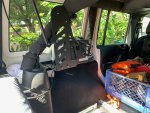SBSYNCRO,
I'm doing what you describe; running a CFX 50 from a "Solar Generator" that I charge from the truck while I drive and from Solar while I fish/park.
1). I use a South African made Flexopower 444 lithium solar generator. 40 ah (amp hours) with multiple output options and built in MPPT solar/input option.
A). I got lucky!! Mine has worked as advertised for 2 years. I can't say that about anyone else in America that I have seen on this and other Overland boards.
B). Will Prowse on you tube and here,
https://www.mobile-solarpower.com/ is a delightful geek in the best ways. He has many reviews of what you are looking at along the lines of a solar generator.
C). I do NOT recommend the Flexopower unit but, since it is what I am using until I make my own, I can address some of your questions.
2). Charging and keeping it charged. I always start with a fully charged generator (444) and pre-chilled CFX (set to 36 degrees).
A). I keep my fridge and the 444 behind my driver seat of my Tacoma. I ran a 10ga hot and cold wire from the starter battery terminals (20' but I might cut it back to 8') w/ a 15amp in line fuse to a Blue Sea 3 banger panel with 2 12v cig outputs (I swapped out the USBs for a 2nd 12v cig) , a volt meter and a on/off switch.
1). While driving, I plug the fridge into 1 of the cigs and the 444 into the other. So I arrive at the river cold and charged.
2). When I arrive, I plug the CFX into the 12v Cig of the 444 to get its power. I NEVER use the 110v converters for anything.
3). Renogy 100watt suitcase - bypassing its own charge controller - and plug the panels straight into the 5mm input connector on the 444. (I did pick up a second 100 watt foldable to add to the set up this year)
4). Fish
5). Depending on the day's weather, 444 gets topped off while running fridge. Without sun, I've lasted over two days using just the 444 which lives in the truck.
A). I do cover my truck with an external sun shade (
https://www.itscoolinhere.com/shop/suv-minivan-large-pick-up-size), crack the windows and put the driver/fridge side of the truck to the North as best as I can. Typically, when the sun is not out, the weather is cooler and the fridge works less/uses less amps.
6). I've done this for as long as 10 days in summer in the West Yellowstone area(s) and many trips up to the Sierra here in CA.
7). On one occasion, I forgot to actually plug the panels in to the 444 after setting them up and "chose" to take a little scenic drive the next day. That charged things up nicely after a couple of hours.
Like many others, I am planning a DIY box with a 100ah Lifepo4 (lithium iron) and a bcdc redarc 1225 and a Blue Sea fuse box with a few output options, so I can have a portable, plug and play set up for my fridge.
Bob






